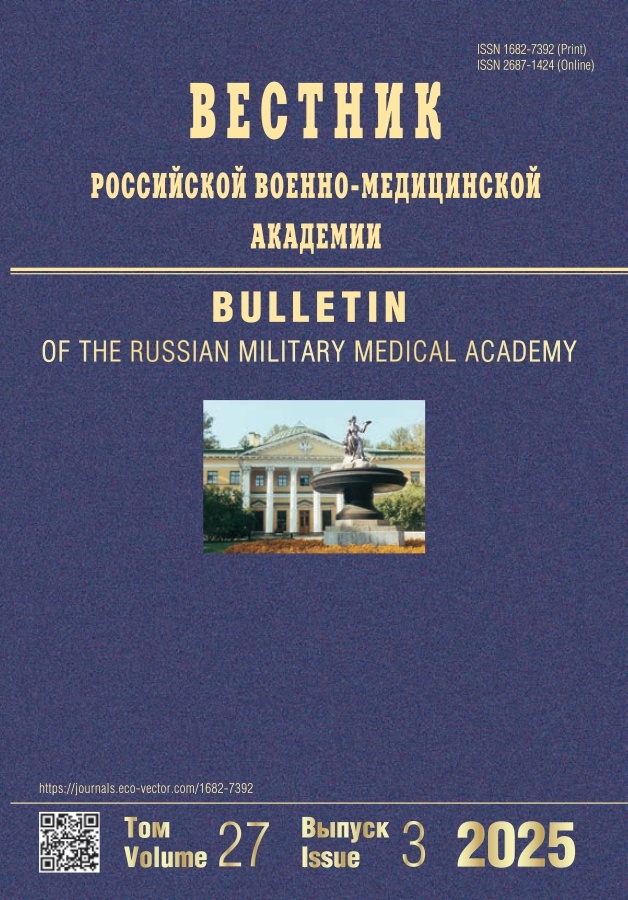Role of ixodid ticks in circulation of Rickettsia conorii and other spotted fever group rickettsiae on the Crimean Peninsula
- Authors: Alieva E.E.1, Gafarova M.T.2
-
Affiliations:
- Saki Military Clinical Sanatorium named after N.I. Pirogov
- V.I. Vernadsky Crimean Federal University
- Issue: Vol 27, No 3 (2025)
- Pages: 353-360
- Section: Original Study Article
- URL: https://bakhtiniada.ru/1682-7392/article/view/319566
- DOI: https://doi.org/10.17816/brmma645373
- EDN: https://elibrary.ru/VPUVJJ
- ID: 319566
Cite item
Abstract
BACKGROUND: In total, 30 ixodid tick species were found on the Crimean Peninsula. Their epidemiological importance was directly correlated with the pathogenicity of the infectious agents that they may transmit. One such established etiological agent is Rickettsia conorii, a representative of the spotted fever group rickettsiae. Rhipicephalus sanguineus ticks serve as both a vector and reservoir for R. conorii. Studying the prevalence of pathogenic agents among the ixodid ticks is particularly crucial given Crimea’s status as a health resort and a center for resort-based medicine.
AIM: This work aimed to assess the role of ixodid ticks in the circulation of R. conorii and other spotted fever group rickettsiae.
METHODS: The ticks were collected from the vegetation, from April to September, for >7 years (2016–2022). For this, flagging and dragging methods, as well as the examination and combing of large and small livestock, horses, dogs, cats, and hedgehogs, were employed. During the outbreaks of Mediterranean spotted fever, ticks were collected from the foci of infection in humans and domestic animals. Genetic markers of rickettsiae were detected using real-time polymerase chain reaction followed by species identification.
RESULTS: In total, nine ixodid tick species were identified from the collected specimens. Overall, the most abundant species were Haemaphysalis punctata (42.9%), Rhipicephalus sanguineus (20.8%), Hyalomma marginatum (15.5%), and Ixodes ricinus (12.8%). The collections were predominated by H. punctata in 2016 (75.5%), H. marginatum in 2017 and 2021 (58.2% and 24.6%, respectively), I. ricinus in 2018 (59.5%), and R. sanguineus in 2019 (47.9%). The DNA of eight spotted fever group rickettsiae species, including R. conorii, R. massiliae, R. sibirica subspp. mongolotimonae, R. slovaca, R. aeschlimannii, R. monacensis, R. helvetica, and R. raoultii were detected in the collected ticks. R. conorii was found in R. sanguineus and H. marginatum. For the first time on the Crimean Peninsula, R. massiliae was detected in R. sanguineus; R. slovaca in Dermacentor marginatus, H. marginatum, H. punctata, R. sanguineus, and I. ricinus; R. mongolotimonae in H. marginatum and R. sanguineus; and R. helvetica in I. ricinus. The greatest diversity of the spotted fever group rickettsiae was recorded in R. sanguineus and H. marginatum.
CONCLUSION: This study established the role of ixodid ticks in the circulation of eight species of spotted fever group rickettsiae on the Crimean Peninsula. They included R. conorii, R. massiliae, R. slovaca, R. raoultii, R. aeschlimannii, R. mongolotimonae, R. monacensis, and R. helvetica. The DNA sequences of R. conorii, R. massiliae, R. slovaca, and R. raoultii were deposited in the GenBank database. These findings on the quantitative and species composition of the ixodid fauna, tick infection rates, and genetic diversity of the detected rickettsiae highlight the need to expand laboratory capabilities, apply a risk-oriented approach, and implement corrective measures to the epidemiological surveillance system of spotted fever group rickettsioses on the peninsula.
Full Text
##article.viewOnOriginalSite##About the authors
Emine E. Alieva
Saki Military Clinical Sanatorium named after N.I. Pirogov
Author for correspondence.
Email: emine.arifova@mail.ru
ORCID iD: 0000-0002-0321-7913
SPIN-code: 6983-9260
Russian Federation, 2 Kurortnaya st., Saki, 296500
Muniver T. Gafarova
V.I. Vernadsky Crimean Federal University
Email: emine.arifova@mail.ru
ORCID iD: 0000-0002-4067-5825
SPIN-code: 8162-4905
MD, Dr. Sci. (Medicine), Professor
Russian Federation, SimferopolReferences
- Alymov AYa. Marseille fever. Sovetskaya Meditsina. 1939;13:30–33. (In Russ.)
- Leibman AL, Klyushkina EA. The spread of Rh. sanguineus latr. ticks in Crimea and the disease of people with Marseilles fever. Zoologicheskii Zhurnal. 1962;41(8):1162–1165. (In Russ.)
- Gafarova MT. Marseille Fever (Epidemiology, Clinic, Diagnostics). Simferopol: Tarpan; 2004. 98 p. (In Russ.)
- Tarasevich IV. Development of knowledge on rickettsiae and rickettsial diseases. Infectious Diseases: News, Views, Education. 2017;(2):22–30. EDN: YLZUOZ
- Zlobin VI, Rudakov NV, Malov IV. Tick-Borne Vector-Borne Infections. Novosibirsk: Nauka; 2015. 224 p. (In Russ.)
- Evstafiev IL, Tovpinets NN. Rhipicephalus sanguineus (Ixodidae) in Crimea: ecological and epizootological aspects. Vestnik Zoologii. 2002;36(4):85–91. (In Russ.)
- Dantas-Torres F. Biology and ecology of the brown dog tick, Rhipicephalus sanguineus. Parasites & Vectors. 2010;3:26. doi: 10.1186/1756-3305-3-26 EDN: JUCRZF
- Alieva EE, Gafarova MT, Bondarenko EI, et al. Use of eschar swab DNA to diagnose Rickettsia conorii subspecies conorii infection in Crimea: A case report. Infectious Medicine. 2023;2(4):338–342. doi: 10.1016/j.imj.2023.09.004 EDN: UHPKDT
- Aliyeva EE, Kozlovsky OA, Fedosov IE, et al. Clinical case of combination of Mediterranean spotted fever and hemorrhagic fever with renal syndrome. Epidemiology and infectious diseases. Current items. 2023;13(4):93–100. doi: 10.18565/epidem.2023.13.4.93-100 EDN: NXMFRZ
- Zvereva NN, Saifullin MA, Karan LS, et al. The case of tick-borne spotted fever in child arriving from the Crimea. Children Infections. 2018;17(4):69–72. doi: 10.22627/2072-8107-2018-17-4-69-72 EDN: YOEEWD
- Filippova NA. Fauna of the USSR. Arachnids. Vol. 4. Issue 4. Ixodid Ticks Subfamily Ixodinae. Leningrad: Nauka; 1977. (In Russ.)
- Bondarenko EI. Detection of genetic markers of tick-borne rickettsiosis pathogens in PCR using the RealBest DNA Rickettsia species and RealBest DNA Rickettsia sibirica/Rickettsia heilongjiangensis reagent kits. Novosti "Vector-Best". 2018;(1):2–10. (In Russ.)
- Gafarova MT, Bondarenko EI, Maly KD, et al. Prevalence of causative agents of transmissive tick-borned ricketsious in the Сrimean peninsula. Clinical Laboratory Diagnostics. 2022;67(3):170–176. doi: 10.51620/0869-2084-2022-67-3-170-176 EDN: MKSWAO
- Alekseev EV. Blood-Sucking and Poisonous Arthropods of Crimea: Monograph. Simferopol: DiIP; 2008. 328 p. (In Russ.)
- Kartashov MYu. Occurrence and Genetic Diversity of Rickettsia in Ticks in Some Regions of Russia. [dissertation abstract]. Novosibirsk; 2017. 169 p. (In Russ.) Available from: https://rusneb.ru/catalog/000199_000009_008711292/
Supplementary files








